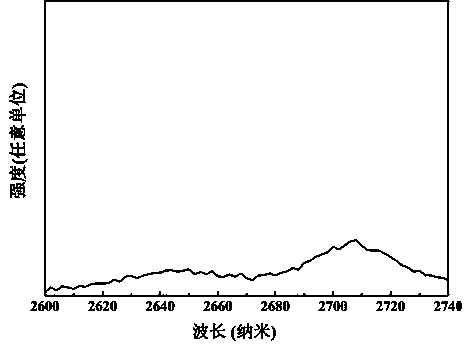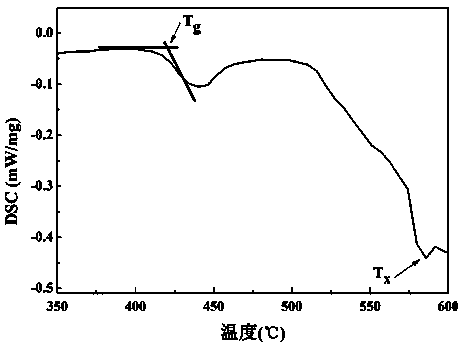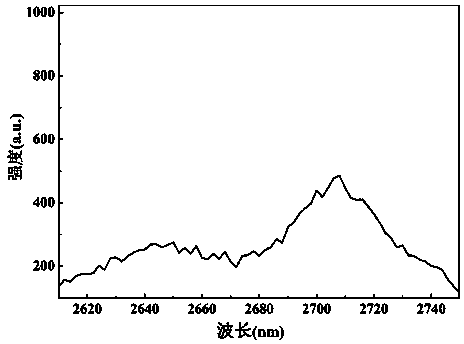Erbium and terbium co-doped fluoride halide phosphate laser glass as well as preparation method and application thereof
A fluorohalophosphate and laser glass technology, applied in the field of fluorohalophosphate laser glass and its preparation, can solve problems such as differential thermal stability, and achieve the effects of low production cost, improved anti-devitrification ability, and simple production process
- Summary
- Abstract
- Description
- Claims
- Application Information
AI Technical Summary
Problems solved by technology
Method used
Image
Examples
Embodiment 1
[0038] According to the formula in Table 1, calculate the weight of the corresponding components, weigh each raw material and mix evenly; put the mixture into a platinum crucible and melt it in a silicon carbide rod electric furnace at 900°C for 20 minutes to obtain molten glass. During the glass melting process, high-purity oxygen is always passed through for atmosphere protection to remove moisture in the molten glass. After being homogenized and clarified, the water-removed glass liquid is quickly poured into a mold that has been preheated to 360°C, and then quickly placed in a muffle furnace that has been heated to 410°C and kept for 2 hours; Reduce the muffle furnace to 100°C, then close the muffle furnace, and cool down to room temperature to obtain the annealed erbium and terbium co-doped fluorohalophosphate laser glass.
[0039] The annealed erbium and terbium co-doped fluorohalophosphate laser glass was processed into a glass piece of 10×20×1 mm and polished, and its ...
Embodiment 2
[0042]According to the formula in Table 1, calculate the weight of the corresponding components, weigh each raw material and mix evenly; put the mixture into a platinum crucible and melt it in a silicon carbide rod electric furnace at 950°C for 15 minutes to obtain molten glass. During the glass melting process, high-purity oxygen is always passed through for atmosphere protection to remove moisture in the molten glass. After being homogenized and clarified, the water-removed glass liquid is quickly poured into a mold that has been preheated to 370°C, and then quickly placed in a muffle furnace that has been heated to 420°C. The rate is lowered to 100° C., then the muffle furnace is closed, and the temperature is lowered to room temperature to obtain an annealed erbium and terbium co-doped fluorohalophosphate laser glass.
[0043] Take the erbium and terbium co-doped fluorohalophosphate laser glass after the above annealing, grind it into a fine powder with an agate mortar, an...
Embodiment 3
[0049] According to the formula in Table 1, calculate the weight of the corresponding components, weigh each raw material and mix evenly; put the mixture into a platinum crucible and melt it in a silicon carbide rod electric furnace at 1000°C for 18 minutes to obtain molten glass. During the glass melting process, high-purity oxygen is always passed through for atmosphere protection to remove moisture in the molten glass. After the dehydrated glass liquid is homogenized and clarified, it is quickly poured into a mold that has been preheated to 370°C, and then quickly placed in a muffle furnace that has been heated to 425°C, and kept for 3 hours, and then heated at a temperature of 9°C / hour. The rate is lowered to 110° C., then the muffle furnace is closed, and the temperature is lowered to room temperature to obtain an annealed erbium and terbium co-doped fluorohalophosphate laser glass.
[0050] The annealed erbium and terbium co-doped fluorohalophosphate laser glass was proc...
PUM
| Property | Measurement | Unit |
|---|---|---|
| Glass transition temperature | aaaaa | aaaaa |
| Glass transition temperature | aaaaa | aaaaa |
| Center wavelength | aaaaa | aaaaa |
Abstract
Description
Claims
Application Information
 Login to View More
Login to View More - Generate Ideas
- Intellectual Property
- Life Sciences
- Materials
- Tech Scout
- Unparalleled Data Quality
- Higher Quality Content
- 60% Fewer Hallucinations
Browse by: Latest US Patents, China's latest patents, Technical Efficacy Thesaurus, Application Domain, Technology Topic, Popular Technical Reports.
© 2025 PatSnap. All rights reserved.Legal|Privacy policy|Modern Slavery Act Transparency Statement|Sitemap|About US| Contact US: help@patsnap.com



